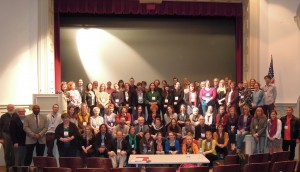Read Pascal Querner’s review of MUSEUM PESTS 2014: Integrated Pest Management for Museums, Libraries, Archives and Historic Sites published in e-conservation Journal 2, 2014, pp. 31-33
To celebrate the ten year anniversary of the IPM Working Group, an ad hoc group of museum and pest professionals who work together each year to create and share IPM resources, a two-day international conference was held earlier this year at Colonial Williamsburg, Virginia. The conference on Integrated Pest Management (IPM) in Museums, Libraries, Archives and Historic Sites inaugurated the newly revamped Museumpests.net, one of the most important IPM resources on the web. MuseumPests.net covers the main issues faced when developing, implementing and managing an IPM, including prevention, monitoring, pest identification, solutions to solve infestations and additional resources like literature on IPM.
The active persons behind the website worked together with the Colonial Williamsburg Foundation Preservation Department to organise the conference, which took place south of Washington from 27th – 28th of March. Some 80 participants met to discuss new challenges in museum IPM from 19 states in the US and Canada as well as Israel, Germany and Austria. In addition to lively talks and poster presentations, the event included an intensive workshop program, visits to the Williamsburg open-air museum and a reception held at the local museum. See the MuseumPests website at https://es.museumpests.net/museumpests-2014-conference for full information on the conference program.
 Some visitors were invited to stay an extra day to participate in the US (East Coast) IPM Working Group meeting with reports on IPM in Europe and updates on the recently updated museumpests.net site.
Some visitors were invited to stay an extra day to participate in the US (East Coast) IPM Working Group meeting with reports on IPM in Europe and updates on the recently updated museumpests.net site.
Keynote talks were given by David Pinniger on Past, Present and Future: The Origins and Spread of Museum Insect Pests and Tom Strang Pest Population Dynamics and Estimating Collection Risk. David Pinniger is the leading IPM specialist in the UK and an independent consultant entomologist with over 30 year of experience on IPM in museums. His presentation described the development of IPM over time and the information we have today including, for example, the spread of pest species. Tom Strang is a senior conservation scientist at the Canadian Conservation Institute; he showed us exactly what can happen if objects are not protected from pests!
Other presentations, papers and posters centred around four main themes relevant to the implementation of IPM in cultural heritage institutions of all types:
- Institutional Implementation of IPM
- Monitoring & Control
- Treatment & Remediation
- IPM Policy, Health & Safety
Like always at IPM conferences, the UK was well represented with talks on Cost effective IPM initiatives in an existing gallery presented by Jane Hymas from the Natural History Museum and IPM Successes and Trials by Suzanne Ryder from the same museum in London. Posters were also presented on the IPM at the Bodleian Libraries of the Oxford University and the Oxford University Museum of Natural History. Contributions from US participants included ongoing work at the Andy Warhol Museum The Accidental IPM Program: A Case Study of Contemporary Art and Archives at The Andy Warhol Museum by Amber E. Morgan and John Samuel Jacobs. Ryan Jones, one of the few people in the world to hold a fulltime IPM position in the museum field (and with a commercial pest company background) presented on Subterranean Termite Prevention in Colonial Williamsburg. Even though the climate at this site is comparable to many central European cities, colleagues from Williamsburg have a tough job preventing damage by termites in the hundreds of wooden buildings that are located there.
Some of the most interesting contributions for me were on IPM Policy, Health, and Safety, moderated by Barbara Appelbaum, a conservator from New York. Investigation into contaminated collections appears to have progressed further in US museums than in European collections, especially concerning the safety of museum staff and policies on how to deal with problematic objects. During this session, there were several presentations by members of the American Institute for Conservation’s Health & Safety committee. Also, the director of the Smithsonian Museum Conservation Institute, Robert J. Koestler, presented an overview of the activity in this museum (which hosts one of the largest collections in the world) over the last 30 years!
The afternoon sessions allowed participants to choose between very diverse and interesting hands-on workshops and on-site tours including:
- Control Options for Termites, Wood Borers and Rodents
- Identification of Insect Pests by Pat Kelley (Vice President of Insects Limited)
- Risk Zone Mapping for IPM by Suzanne Ryder
- Introduction to Integrated Pest Management Principles and Practice
- Computerized Record Keeping for Pest Trapping Data
- Treatment and Remediation of Infestations and more…
The conference was organised by Patty Silence, conservator at the Colonial Williamsburg Foundation, Ryan Jones, Integrated Pest Management Specialist at the foundation and their helpers and colleagues. Many thanks to all of them for what was a great conference held in a unique location. Posters, presentations and most papers are already online at www.museumpests.net. The next big international conference will be in Paris in 2016.
Pascal Querner
Entomologist
pascal.querner@boku.ac.at
